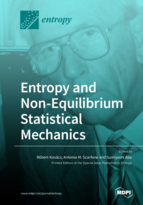Entropy and Non-Equilibrium Statistical Mechanics
A special issue of Entropy (ISSN 1099-4300). This special issue belongs to the section "Statistical Physics".
Deadline for manuscript submissions: closed (18 March 2020) | Viewed by 30116
Special Issue Editors
Interests: nonextensive statistical mechanics; nonlinear Fokker–Planck equations; geometry information; nonlinear Schroedinger equation; quantum groups and quantum algebras; complex systems
Special Issues, Collections and Topics in MDPI journals
2. Institute of Physics, Kazan Federal University, 420008 Kazan, Russia
3. Department of Natural and Mathematical Sciences, Turin Polytechnic University in Tashkent, Tashkent 100095, Uzbekistan
Interests: statistical mechanics; quantum entanglement and quantum information; complex systems
Interests: continuum mechanics and thermodynamics; internal variables; kinetic theory; numerical and analytical solutions of partial differential equations
Special Issues, Collections and Topics in MDPI journals
Special Issue Information
Dear Colleagues,
Non-equilibrium statistical mechanics has a long history and diverse aspects. It has been a major research field in physics and will remain so in the future. Even regarding the concept of entropy, there exists a longstanding problem concerning its definition for a system in a state far from equilibrium.
The aim of this Special Issue is to offer the possibility to discuss and present up-to-date problems that may not be restricted to statistical mechanics. Theoretical and experimental papers are both accepted and unifying research works that address both of them are encouraged. As the entropy itself is the central element of non-equilibrium processes, papers discussing various formulations of the second law and consequences are also welcome.
In this Special Issue, recent progress in kinetic approaches to hydrodynamics, rational extended thermodynamics, entropy in a strongly non-equilibrium stationary state, and related topics will be reported. Review articles as well as the original research works will be presented.
Dr. Antonio M. Scarfone
Prof. Dr. Sumiyoshi Abe
Dr. Róbert Kovács
Guest Editors
Manuscript Submission Information
Manuscripts should be submitted online at www.mdpi.com by registering and logging in to this website. Once you are registered, click here to go to the submission form. Manuscripts can be submitted until the deadline. All submissions that pass pre-check are peer-reviewed. Accepted papers will be published continuously in the journal (as soon as accepted) and will be listed together on the special issue website. Research articles, review articles as well as short communications are invited. For planned papers, a title and short abstract (about 100 words) can be sent to the Editorial Office for announcement on this website.
Submitted manuscripts should not have been published previously, nor be under consideration for publication elsewhere (except conference proceedings papers). All manuscripts are thoroughly refereed through a single-blind peer-review process. A guide for authors and other relevant information for submission of manuscripts is available on the Instructions for Authors page. Entropy is an international peer-reviewed open access monthly journal published by MDPI.
Please visit the Instructions for Authors page before submitting a manuscript. The Article Processing Charge (APC) for publication in this open access journal is 2600 CHF (Swiss Francs). Submitted papers should be well formatted and use good English. Authors may use MDPI's English editing service prior to publication or during author revisions.
Keywords
- non-equilibrium phenomena
- kinetic theory
- second law of thermodynamics
- statistical distributions
- stochastic processes
Benefits of Publishing in a Special Issue
- Ease of navigation: Grouping papers by topic helps scholars navigate broad scope journals more efficiently.
- Greater discoverability: Special Issues support the reach and impact of scientific research. Articles in Special Issues are more discoverable and cited more frequently.
- Expansion of research network: Special Issues facilitate connections among authors, fostering scientific collaborations.
- External promotion: Articles in Special Issues are often promoted through the journal's social media, increasing their visibility.
- e-Book format: Special Issues with more than 10 articles can be published as dedicated e-books, ensuring wide and rapid dissemination.
Further information on MDPI's Special Issue polices can be found here.








